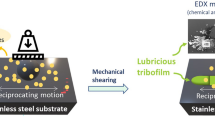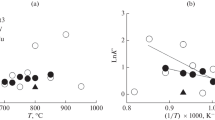Abstract
The surface tribological chemistry of acetic acid on copper is studied using an ultrahigh vacuum tribometer, supplemented by first-principles density functional theory calculations of the surface structure and reaction pathways. Acetic acid forms η2-acetate species on bridge sites at room temperature as identified by reflection–absorption infrared spectroscopy. Rubbing the surface with a tungsten carbide ball reduces the amount of carbon and oxygen in the rubbed region at the same rates to leave some carbon and oxygen on the surface. This is different from the thermal decomposition pathway, where heating to ~ 580 K removes all oxygen, but leave a small amount of carbon on the surface. It is postulated that this arises because sliding along a direction aligned within the plane of the adsorbed acetate species can induce a high-energy-barrier pathway in which the η2-acetate tilts to form an η1-acetate that can react to form a bent CO2δ− species that decomposes to evolve carbon monoxide and deposit atomic oxygen on the surface. Repeated acetic acid dosing and rubbing reduces the total amount of acetic acid that can adsorb on the surface by ~ 50% after ~ 4 cycles, resulting is a stable, low-friction film. At this point, the adsorbed acetic acid is completely tribochemically removed. This suggests that adsorbed acetic acid can form a self-healing film in which any wear of the low-friction film will then allow it to be replenished by shear-induced decomposition of adsorbed acetate species.







Similar content being viewed by others
References
Clayton, D.: An introduction to boundary and extreme pressure lubrication. Br. J. Appl. Phys. 2, 25 (1951)
Westlake, F.J., Cameron, A.: A study of ultra-thin lubricant films using an optical technique. Proc. Inst. Mech. Eng. 182, 75–78 (1967)
Tonck, A., Martin, J.M., Kapsa, P., Georges, J.M.: Boundary lubrication with anti-wear additives: study of interface film formation by electrical contact resistance. Tribol. Int. 12, 209–213 (1979)
Hsu, S.M., Gates, R.S.: Boundary lubricating films: formation and lubrication mechanism. Tribol. Int. 38, 305–312 (2005)
Spikes, H.: Friction modifier additives. Tribol. Lett. 60, 5 (2015)
Simič, R., Kalin, M.: Adsorption mechanisms for fatty acids on DLC and steel studied by AFM and tribological experiments. Appl. Surf. Sci. 283, 460–470 (2013)
Kano, M., Martin, J.M., Yoshida, K., De Barros-Bouchet, M.I.: Super-low friction of ta-C coating in presence of oleic acid. Friction 2, 156–163 (2014)
De Barros Bouchet, M.I., Martin, J.M., Avila, J., Kano, M., Yoshida, K., Tsuruda, T., et al.: Diamond-like carbon coating under oleic acid lubrication: evidence for graphene oxide formation in superlow friction. Sci. Rep. 7, 46394 (2017)
De Barros Bouchet, M.I., Martin, J.M., Forest, C., le Mogne, T., Mazarin, M., Avila, J., et al.: Tribochemistry of unsaturated fatty acids as friction modifiers in (bio)diesel fuel. RSC Adv. 7, 33120–33131 (2017)
Campen, S., Green, J.H., Lamb, G.D., Spikes, H.A.: In situ study of model organic friction modifiers using liquid cell AFM; saturated and mono-unsaturated carboxylic acids. Tribol. Lett. 57, 18 (2015)
Lundgren, S.M., Ruths, M., Danerlöv, K., Persson, K.: Effects of unsaturation on film structure and friction of fatty acids in a model base oil. J. Colloid Interface Sci. 326, 530–536 (2008)
Kuwahara, T., Romero, P.A., Makowski, S., Weihnacht, V., Moras, G., Moseler, M.: Mechano-chemical decomposition of organic friction modifiers with multiple reactive centres induces superlubricity of ta-C. Nat. Commun. 10, 151 (2019)
Sawyer, W.G., Wahl, K.J.: Accessing inaccessible interfaces: in situ approaches to materials tribology. J. MRS Bull. 33, 1145–1150 (2008)
Furlong, O.J., Miller, B.P., Kotvis, P., Tysoe, W.T.: Low-temperature, shear-induced tribofilm formation from dimethyl disulfide on copper. ACS Appl. Mater. Interfaces. 3, 795–800 (2011)
Furlong, O., Miller, B., Tysoe, W.: Shear-induced surface-to-bulk transport at room temperature in a sliding metal-metal interface. Tribol. Lett. 41, 257–261 (2011)
Furlong, O., Miller, B., Tysoe, W.T.: Shear-induced boundary film formation from dialkyl sulfides on copper. Wear 274–275, 183–187 (2012)
Miller, B., Furlong, O., Tysoe, W.: The kinetics of shear-induced boundary film formation from dimethyl disulfide on copper. Tribol. Lett. 49, 39–46 (2013)
Adams, H.L., Garvey, M.T., Ramasamy, U.S., Ye, Z., Martini, A., Tysoe, W.T.: Shear-induced mechanochemistry: pushing molecules around. J. Phys. Chem. C 119, 7115–7123 (2015)
Adams, H., Miller, B.P., Kotvis, P.V., Furlong, O.J., Martini, A., Tysoe, W.T.: In situ measurements of boundary film formation pathways and kinetics: dimethyl and diethyl disulfide on copper. Tribol. Lett. 62, 1–9 (2016)
Adams, H., Miller, B.P., Furlong, O.J., Fantauzzi, M., Navarra, G., Rossi, A., et al.: Modeling mechanochemical reaction mechanisms. ACS Appl. Mater. Interfaces. 9, 26531–26538 (2017)
Boscoboinik, A., Olson, D., Adams, H., Hopper, N., Tysoe, W.T.: Measuring and modelling mechanochemical reaction kinetics. Chem. Commun. 56, 7730–7733 (2020)
Miller, B.P., Furlong, O.J., Tysoe, W.T.: Surface chemistry of isopropoxy tetramethyl dioxaborolane on Cu(111). Langmuir 28, 6322–6327 (2012)
Miller, B., Kotvis, P., Furlong, O., Tysoe, W.: Relating molecular structure to tribological chemistry: borate esters on copper. Tribol. Lett. 49, 21–29 (2013)
Rana, R., Tysoe, W.: Tribochemical mechanisms of trimethyl and triethyl phosphite on oxidized iron in ultrahigh vacuum. Tribol. Lett. 67, 93 (2019)
Sexton, B.A.: The structure of acetate species on copper (100). Chem. Phys. Lett. 65, 469–471 (1979)
Bowker, M., Madix, R.J.: The adsorption and oxidation of acetic acid and acetaldehyde on Cu(110). Appl. Surf. Sci. 8, 299–317 (1981)
Fuhrmann, D., Wacker, D., Weiss, K., Hermann, K., Witko, M., Woll, C.: The adsorption of small hydrocarbons on Cu(111): a combined He-atom scattering and x-ray absorption study for ethane, ethylene, and acetylene. J. Chem. Phys. 108, 2651–2658 (1998)
Wühn, M., Weckesser, J., Wöll, C.: Bonding and orientational ordering of long-chain carboxylic acids on Cu(111): investigations using x-ray absorption spectroscopy. Langmuir 17, 7605–7612 (2001)
Immaraporn, B., Ye, P., Gellman, A.J.: The transition state for carboxylic acid deprotonation on Cu(100). J. Phys. Chem. B 108, 3504–3511 (2004)
Karagoz, B., Reinicker, A., Gellman, A.J.: Kinetics and mechanism of aspartic acid adsorption and its explosive decomposition on Cu(100). Langmuir 35, 2925–2933 (2019)
Furlong, O.J., Miller, B.P., Li, Z., Walker, J., Burkholder, L., Tysoe, W.T.: The surface chemistry of dimethyl disulfide on copper. Langmuir 26, 16375–16380 (2010)
Kaltchev, M., Thompson, A.W., Tysoe, W.T.: Reflection-absorption infrared spectroscopy of ethylene on palladium (111) at high pressure. Surf. Sci. 391, 145–149 (1997)
Gao, F., Furlong, O., Kotvis, P.V., Tysoe, W.T.: Pressure dependence of shear strengths of thin films on metal surfaces measured in ultrahigh vacuum. Tribol. Lett. 31, 99–106 (2008)
Rana, R., Long, D., Kotula, P., Xu, Y., Olson, D., Galipaud, J., et al. Insights into the mechanism of the mechanochemical formation of metastable phases. ACS Appl. Mater. Interfaces. 13, 6785–6794 (2021)
Kresse, G., Hafner, J.: Ab initio molecular dynamics for liquid metals. Phys. Rev. B 47, 558–561 (1993)
Kresse, G., Furthmüller, J.: Efficiency of ab-initio total energy calculations for metals and semiconductors using a plane-wave basis set. Comput. Mater. Sci. 6, 15–50 (1996)
Kresse, G., Furthmüller, J.: Efficient iterative schemes for ab initio total-energy calculations using a plane-wave basis set. Phys. Rev. B 54, 11169–11186 (1996)
Perdew, J.P., Burke, K., Ernzerhof, M.: Generalized gradient approximation made simple. Phys. Rev. Lett. 77, 3865 (1996)
Grimme, S., Antony, J., Ehrlich, S., Krieg, H.: A consistent and accurate ab initio parametrization of density functional dispersion correction (DFT-D) for the 94 elements H-Pu. J. Chem. Phys. 132, 154104 (2010)
Henkelman, G., Uberuaga, B.P., Jonsson, H.: A climbing image nudged elastic band method for finding saddle points and minimum energy paths. J. Chem. Phys. 113, 9901–9904 (2000)
Henkelman, G., Jónsson, H.: Improved tangent estimate in the nudged elastic band method for finding minimum energy paths and saddle points. J. Chem. Phys. 113, 9978–9985 (2000)
Canning, N., Madix, R.J.: Towards an organometallic chemistry of surfaces. J. Phys. Chem. 88, 2437–2446 (1984)
Greenler, R.G.: Infrared study of adsorbed molecules on metal surfaces by reflection techniques. J. Chem. Phys. 44, 310–315 (1966)
Greenler, R.G., Snider, D.R., Witt, D., Sorbello, R.S.: The metal-surface selection rule for infrared spectra of molecules adsorbed on small metal particles. Surf. Sci. 118, 415–428 (1982)
Hagman, B., Posada-Borbón, A., Schaefer, A., Shipilin, M., Zhang, C., Merte, L.R., et al.: Steps control the dissociation of CO2 on Cu(100). J. Am. Chem. Soc. 140, 12974–12979 (2018)
Yang, T., Gu, T., Han, Y., Wang, W., Yu, Y., Zang, Y., et al.: Surface orientation and pressure dependence of CO2 activation on Cu surfaces. J. Phys. Chem. C. (2020). https://doi.org/10.1021/acs.jpcc.0c08262
Tysoe, W.: On stress-induced tribochemical reaction rates. Tribol. Lett. 65, 48 (2017)
Acknowledgements
We gratefully acknowledge the Civil, Mechanical and Manufacturing Innovation (CMMI) Division of the National Science Foundation under Grant Number CMMI-2020525 for support of this work.
Author information
Authors and Affiliations
Corresponding author
Additional information
Submitted to the special issue in memory of Mark Robbins.
Publisher's Note
Springer Nature remains neutral with regard to jurisdictional claims in published maps and institutional affiliations.
Rights and permissions
About this article
Cite this article
Rana, R., Bavisotto, R., Hopper, N. et al. Inducing High-Energy-Barrier Tribochemical Reaction Pathways; Acetic Acid Decomposition on Copper. Tribol Lett 69, 32 (2021). https://doi.org/10.1007/s11249-021-01407-z
Received:
Accepted:
Published:
DOI: https://doi.org/10.1007/s11249-021-01407-z




